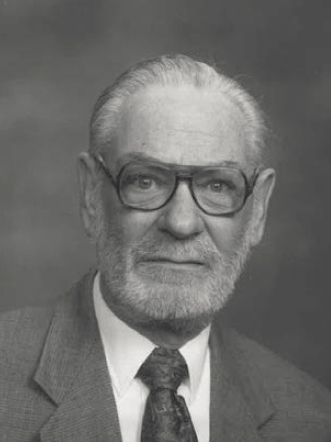
RALPH L. DISNEY
1928–2014
Elected in 1997
“For contributions in the development of the field of queueing networks and its applications.”
RALPH LYNDE DISNEY JR. died November 11, 2014, at age 86. Known by many as the father of queueing networks, he was a world leader in queueing theory, a branch of applied probability and stochastic processes mathematics. He authored or coauthored more than 70 refereed research articles, three books, and numerous articles. He was also a prolific reviewer of articles both pre- and postpublication, including more than 150 reviews for the Mathematics Reviews.
Ralph was born February 27, 1928, in Baltimore, Maryland, and graduated in 1946 from McDonogh High School (Glyndon, MD), where he earned nine letters in football, basketball, and baseball, wrote for the school newspaper, and was captain of the band.
He entered Johns Hopkins University but left for financial and academic reasons in 1948. He returned in 1950 and completed his bachelor’s degree in industrial engineering (1952). He was indebted to Robert H. Roy, dean of engineering, for giving him a second chance after his earlier departure.
As an undergraduate, he played 2 years for the JHU baseball team and was inducted into the Tudor and Stuart Club, an honorary association of students and faculty interested in English and history studies. He was proud of this membership as he was one of the few engineering students admitted.
He went on to earn his master’s in systems engineering (1955) and doctorate in engineering (1964), both at JHU. His doctoral dissertation, Some Problems in the Theory of Conveyors and Their Analysis by Method of Decomposition of Queueing Networks, was supervised by Roy and probabilist Bruce Clarke.
As a graduate student Ralph worked with the Operations Research of America Society (ORSA), where he met his future wife, Lois Loghry DuFrain, one of the few women in OR at the time. They married in 1955.
An outstanding teacher, Ralph’s career as an educator began even before he received his doctorate, when he was a full-time tutor in 1952. Between his master’s degree and doctorate, he taught at Lamar State College of Technology (now Lamar University) in Beaumont, Texas, enrolling one of the first Black students in the college in 1956 after the Supreme Court’s 1955 ruling on Brown v. Board of Education, a courageous act in that time and place.
He moved to the University of Buffalo in New York as an associate professor in 1959 and established the school’s first scientific computing laboratory after attending an early course on minicomputers sponsored by the National Science Foundation. In 1962 he became a visiting professor at the University of Michigan and, after receiving his doctorate, accepted a tenured position, ultimately rising to full professor.
Ralph was a leader in restructuring the industrial engineering curriculum at Michigan, developing an approach that was emulated by many universities around the country. Connected with his contributions to a new approach to industrial engineering education, he developed new courses that resulted in the publication of a textbook coauthored with Clarke, Probability and Random Processes for Engineers and Scientists (John Wiley & Sons, 1970), reissued in 1985 as Probability and Random Processes: A First Course with Applications, 2nd ed. (John Wiley & Sons). He went on to become the Charles O. Gordon Professor of Industrial Engineering at Virginia Polytechnic Institute and State University in 1977, helping build an internationally recognized program in queueing theory and applied probability.
He left Virginia Tech to join the faculty at Texas A&M in 1988, and remained there until his retirement in 1996.
Over his long and varied academic career, he advised and mentored more than 20 doctoral students from around the world and in different academic disciplines, and he influenced countless others.
Ralph gave generously of his time to the profession. With ORSA and the Institute of Management Sciences (TIMS), he created and led the Applied Probability College (today’s Applied Probability Society) in the 1980s. He served on the Council of TIMS and ORSA’s successor, the Institute for Operations Research and the Management Sciences (INFORMS). He was a founder and chair (1981–82) of the Applied Probability Society of INFORMS, and senior editor of the Industrial Engineering Institute’s research journal.
Ralph lectured at research forums and in many of the major research centers throughout the world. In 1970 he became the Organization of American States (OAS) Professor at the Aeronautics Institute in São José dos Campos, Brazil, and subsequently spent time at the University of São Paulo. In 1975 he was appointed a Distinguished Visiting Professor at the Ohio State University. He was invited to lecture at several universities in Japan, and in New Zealand (1995–96) he was named an Erskine Fellow at the University of Canterbury, Christchurch, and consulted with and jointly performed research with faculty members at Massey University in Auckland. He also lectured in both Thailand and Singapore.
Throughout his career, he earned many honors. These included the David F. Baker Award for outstanding research in the profession (1972) and Albert E. Holzman Distinguished Educators Award (1986), both from the Institute of Industrial and Systems Engineers (IISE), and in 1993 the prestigious Frank and Lillian Gilbreth Award, the highest honor bestowed by IISE for distinguished contributions to the welfare of mankind in the field of industrial engineering. He was a fellow of IISE and an inaugural fellow of INFORMS.
Ralph and Lois retired in 1996 to Blacksburg, Virginia, where they had many friends. In 2006 they moved to Warm
Hearth Village, a retirement community in Blacksburg, where he returned to an interest from his undergraduate days, taking up nontechnical writing as a hobby and joining the community’s writers’ group. In 1998 they became snowbirds, spending their winters in Fort Myers, Florida.
Ralph and Lois lived together happily for 53 years until Lois’s death in 2007. They are survived by daughters Lynn D. Disney (Rolf K. Taylor) of Annandale, Virginia, and Carrie M. Disney (Mark R. Stangl) of Ann Arbor; five grandchildren; and one great-grandchild.






